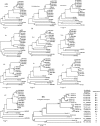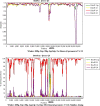Genomic analyses of recombinant adenovirus type 11a in China
- PMID: 19675212
- PMCID: PMC2756911
- DOI: 10.1128/JCM.00282-09
Genomic analyses of recombinant adenovirus type 11a in China
Abstract
Whole-genome sequencing of human adenovirus type 11 (HAdV-11) strain QS, isolated in China, was conducted, and its sequence was compared with the sequences of strains within the species of HAdVs. The HAdV-11 QS genome contains 34,755 nucleotides. Similar to the other HAdV subgenus B sequences, the HAdV-11 QS genome coded 37 functional proteins and could be divided into four early, two intermediate, and five late transcription regions. The amino acid sequences of the fiber and the hypervariable regions (HVRs) within the hexon gene of HAdV-11 QS were identical to the corresponding sequences of the HAdV-11a strain; further analyses that compared those amino acid sequences with the amino acid sequences of the HAdV species subgenus B:2 strains revealed that the highest degree of homology (>99.2%) existed between HAdV-11 QS and the prototypical HAdV-14 strain, except for a few coding sequences of HVRs within the hexon gene, DNA polymerase, pVI, and pre-terminal protein. This indicate that HAdV-11 strain QS, isolated in China, is a recombinant adenovirus of HAdV-14, and the recombination analyses also confirmed this finding. It is difficult to clarify the time and manner of the recombination, and further investigations are required to determine whether the emergence of recombination between HAdV-11a and HAdV-14 might increase virulence, thereby posing a new global challenge with regard to acute respiratory diseases in the near future.
Figures


Similar articles
-
Isolation and characterization of a novel recombinant human adenovirus species D.J Med Microbiol. 2012 Aug;61(Pt 8):1097-1102. doi: 10.1099/jmm.0.042176-0. Epub 2012 Apr 26. J Med Microbiol. 2012. PMID: 22538999
-
Analysis of the complete genome sequence of epidemic keratoconjunctivitis-related human adenovirus type 8, 19, 37 and a novel serotype.J Gen Virol. 2009 Jun;90(Pt 6):1471-1476. doi: 10.1099/vir.0.009225-0. Epub 2009 Mar 4. J Gen Virol. 2009. PMID: 19264666
-
Recombination analysis of Human mastadenovirus C whole genomes.Sci Rep. 2019 Feb 18;9(1):2182. doi: 10.1038/s41598-019-38719-z. Sci Rep. 2019. PMID: 30778154 Free PMC article.
-
Genomic Evolution and Recombination Dynamics of Human Adenovirus D Species: Insights from Comprehensive Bioinformatic Analysis.J Microbiol. 2024 May;62(5):393-407. doi: 10.1007/s12275-024-00112-5. Epub 2024 Mar 7. J Microbiol. 2024. PMID: 38451451 Review.
-
Human adenovirus type 8: the major agent of epidemic keratoconjunctivitis (EKC).J Clin Virol. 2014 Dec;61(4):477-86. doi: 10.1016/j.jcv.2014.10.015. Epub 2014 Nov 4. J Clin Virol. 2014. PMID: 25464969 Review.
Cited by
-
Adenoviruses associated with acute respiratory diseases reported in Beijing from 2011 to 2013.PLoS One. 2015 Mar 27;10(3):e0121375. doi: 10.1371/journal.pone.0121375. eCollection 2015. PLoS One. 2015. PMID: 25816320 Free PMC article.
-
Case-control study of the epidemiological and clinical features of human adenovirus 55 and human adenovirus 7 infection in children with acute lower respiratory tract infections in Beijing, China, 2008-2013.BMC Infect Dis. 2018 Dec 7;18(1):634. doi: 10.1186/s12879-018-3520-z. BMC Infect Dis. 2018. PMID: 30526511 Free PMC article.
-
Genome Analysis of A Novel Recombinant Human Adenovirus Type 1 in China.Sci Rep. 2019 Mar 12;9(1):4298. doi: 10.1038/s41598-018-37756-4. Sci Rep. 2019. PMID: 30862832 Free PMC article.
-
Severe Adenovirus Pneumonia Requiring Extracorporeal Membrane Oxygenation Support in Immunocompetent Children.Front Pediatr. 2020 Apr 15;8:162. doi: 10.3389/fped.2020.00162. eCollection 2020. Front Pediatr. 2020. PMID: 32351920 Free PMC article.
-
Human Adenovirus Type 55 Distribution, Regional Persistence, and Genetic Variability.Emerg Infect Dis. 2020 Jul;26(7):1497-1505. doi: 10.3201/eid2607.191707. Emerg Infect Dis. 2020. PMID: 32568062 Free PMC article.
References
-
- Benkö, M., B. Harrach, G. W. Both, W. C. Russell, B. M. Adair, É. Ádam, J. C. de Jong, M. Hess, M. Johnson, A. Kajon, A. H. Kidd, H. D. Lehmkuhl, Q.-G. Li, V. Mautner, P. Pring-Akerblom, and G. Wadell. 2005. Family Adenoviridae, p. 213-228. In C. M. Fauquet, M. A. Mayo, J. Maniloff, U. Desselberger, and L. A. Ball (ed.), Virus taxonomy. Eighth report of the International Committee on the Taxonomy of Viruses. Elsevier Academic Press, San Diego, CA.
-
- Berk, A. J. 2007. Adenoviridae: the viruses and their replication, p. 2355-2394. In D. M. Knipe and P. M. Howley (ed.), Fields virology, 5th ed. Lippincott Williams & Wilkins, Philadelphia, PA.
-
- Caillet-Boudin, M. L. 1989. Complementary peptide sequences in partner proteins of the adenovirus capsid. J. Mol. Biol. 208:195-198. - PubMed
Publication types
MeSH terms
Substances
Associated data
- Actions
LinkOut - more resources
Full Text Sources

